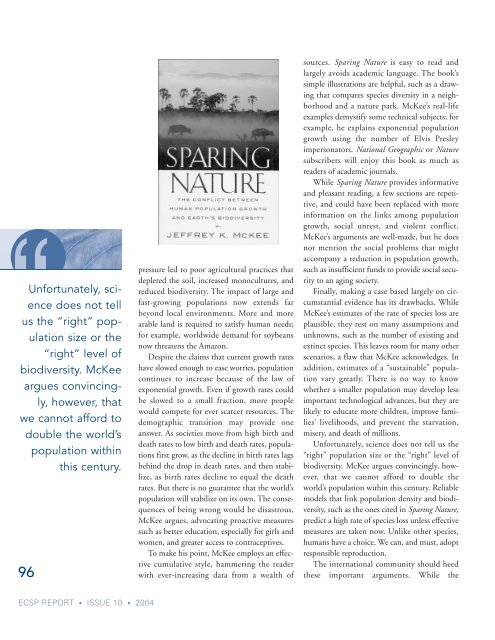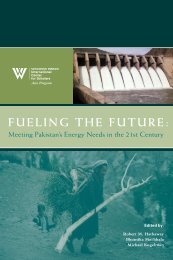Environmental Change and Security Project Report - Woodrow ...
Environmental Change and Security Project Report - Woodrow ...
Environmental Change and Security Project Report - Woodrow ...
You also want an ePaper? Increase the reach of your titles
YUMPU automatically turns print PDFs into web optimized ePapers that Google loves.
Unfortunately, science<br />
does not tell<br />
us the “right” population<br />
size or the<br />
“right” level of<br />
biodiversity. McKee<br />
argues convincingly,<br />
however, that<br />
we cannot afford to<br />
double the world’s<br />
population within<br />
this century.<br />
96<br />
pressure led to poor agricultural practices that<br />
depleted the soil, increased monocultures, <strong>and</strong><br />
reduced biodiversity. The impact of large <strong>and</strong><br />
fast-growing populations now extends far<br />
beyond local environments. More <strong>and</strong> more<br />
arable l<strong>and</strong> is required to satisfy human needs;<br />
for example, worldwide dem<strong>and</strong> for soybeans<br />
now threatens the Amazon.<br />
Despite the claims that current growth rates<br />
have slowed enough to ease worries, population<br />
continues to increase because of the law of<br />
exponential growth. Even if growth rates could<br />
be slowed to a small fraction, more people<br />
would compete for ever scarcer resources. The<br />
demographic transition may provide one<br />
answer. As societies move from high birth <strong>and</strong><br />
death rates to low birth <strong>and</strong> death rates, populations<br />
first grow, as the decline in birth rates lags<br />
behind the drop in death rates, <strong>and</strong> then stabilize,<br />
as birth rates decline to equal the death<br />
rates. But there is no guarantee that the world’s<br />
population will stabilize on its own. The consequences<br />
of being wrong would be disastrous,<br />
McKee argues, advocating proactive measures<br />
such as better education, especially for girls <strong>and</strong><br />
women, <strong>and</strong> greater access to contraceptives.<br />
To make his point, McKee employs an effective<br />
cumulative style, hammering the reader<br />
with ever-increasing data from a wealth of<br />
sources. Sparing Nature is easy to read <strong>and</strong><br />
largely avoids academic language. The book’s<br />
simple illustrations are helpful, such as a drawing<br />
that compares species diversity in a neighborhood<br />
<strong>and</strong> a nature park. McKee’s real-life<br />
examples demystify some technical subjects; for<br />
example, he explains exponential population<br />
growth using the number of Elvis Presley<br />
impersonators. National Geographic or Nature<br />
subscribers will enjoy this book as much as<br />
readers of academic journals.<br />
While Sparing Nature provides informative<br />
<strong>and</strong> pleasant reading, a few sections are repetitive,<br />
<strong>and</strong> could have been replaced with more<br />
information on the links among population<br />
growth, social unrest, <strong>and</strong> violent conflict.<br />
McKee’s arguments are well-made, but he does<br />
not mention the social problems that might<br />
accompany a reduction in population growth,<br />
such as insufficient funds to provide social security<br />
to an aging society.<br />
Finally, making a case based largely on circumstantial<br />
evidence has its drawbacks. While<br />
McKee’s estimates of the rate of species loss are<br />
plausible, they rest on many assumptions <strong>and</strong><br />
unknowns, such as the number of existing <strong>and</strong><br />
extinct species. This leaves room for many other<br />
scenarios, a flaw that McKee acknowledges. In<br />
addition, estimates of a “sustainable” population<br />
vary greatly. There is no way to know<br />
whether a smaller population may develop less<br />
important technological advances, but they are<br />
likely to educate more children, improve families’<br />
livelihoods, <strong>and</strong> prevent the starvation,<br />
misery, <strong>and</strong> death of millions.<br />
Unfortunately, science does not tell us the<br />
“right” population size or the “right” level of<br />
biodiversity. McKee argues convincingly, however,<br />
that we cannot afford to double the<br />
world’s population within this century. Reliable<br />
models that link population density <strong>and</strong> biodiversity,<br />
such as the ones cited in Sparing Nature,<br />
predict a high rate of species loss unless effective<br />
measures are taken now. Unlike other species,<br />
humans have a choice. We can, <strong>and</strong> must, adopt<br />
responsible reproduction.<br />
The international community should heed<br />
these important arguments. While the<br />
ECSP REPORT • ISSUE 10 • 2004

















